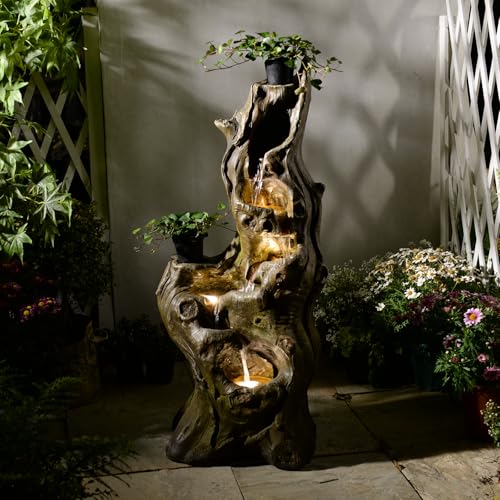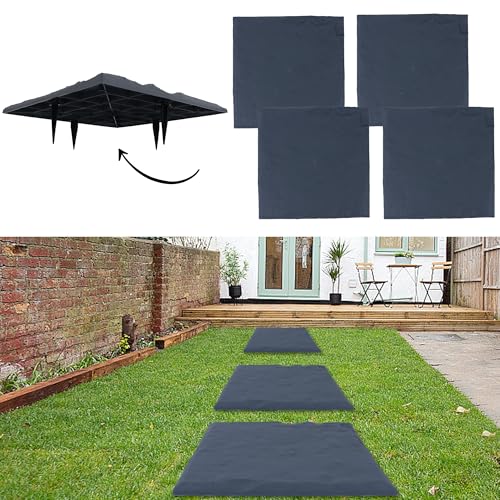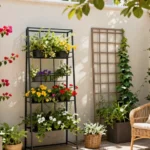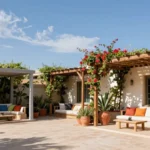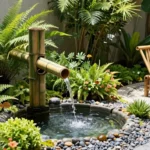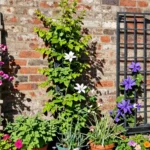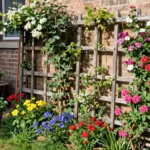Owning a one-acre backyard is like having your own private paradise waiting to be transformed. We’ve all dreamed of maximizing our outdoor space but when you’re working with an entire acre the possibilities can feel overwhelming. Where do you start? What features should you prioritize?
We understand that turning your expansive backyard into a functional and beautiful outdoor living space requires careful planning and creative vision. Whether you’re envisioning entertainment areas for hosting epic gatherings or peaceful retreats for quiet relaxation your acre of land offers endless potential.
From luxurious swimming pools and outdoor kitchens to productive vegetable gardens and charming play areas we’ll explore the most impactful ways to design your dream backyard. Let’s jump into practical ideas that’ll help you create distinct zones maximize your property’s value and design an outdoor space that perfectly reflects your lifestyle and needs.
Create Multiple Outdoor Living Zones for Entertainment and Relaxation
Designing distinct outdoor living zones transforms your one-acre backyard into a sophisticated entertainment haven. Strategic placement of these areas creates natural flow between spaces while maximizing functionality.
Design a Large Patio or Deck Area
Expansive patios serve as the foundation for outdoor entertainment on your one-acre property. Natural stone pavers, concrete slabs, or composite decking materials create durable surfaces that withstand weather and heavy foot traffic. We recommend sizing your patio at least 400-600 square feet to accommodate dining furniture, lounge seating, and walking space.
Multi-level decking systems add visual interest while defining separate activity zones. Elevated sections work perfectly for dining areas, while lower levels accommodate conversation pits or hot tub installations. Cedar, pressure-treated lumber, or low-maintenance composite materials provide long-lasting construction options.
Strategic placement near your home’s main entrance creates seamless indoor-outdoor transitions. Position patios within 20-30 feet of kitchen doors or sliding glass panels to help easy entertaining and food service. Pergolas, shade sails, or retractable awnings extend usability during sunny afternoons.
Install a Fire Pit or Outdoor Fireplace
Central fire features create natural gathering spots that extend outdoor season usage. Stone fire pits typically cost $300-$1,500 for DIY installations, while custom outdoor fireplaces range from $3,000-$15,000 depending on materials and complexity. Gas-powered options offer convenience, while wood-burning varieties provide authentic ambiance.
Seating arrangements around fire features encourage conversation and relaxation. Built-in stone benches, moveable outdoor furniture, or custom curved seating walls accommodate 8-12 people comfortably. We suggest maintaining 6-8 feet clearance between seating and fire sources for safety.
Location selection impacts both functionality and safety in your backyard design. Position fire features at least 10 feet from structures, property lines, and overhanging trees. Central placement creates focal points, while corner installations maximize open space for activities.
Set Up an Outdoor Kitchen and Dining Space
Full outdoor kitchens transform your backyard into a complete entertaining destination. Essential components include built-in grills, refrigeration units, sink stations, and ample counter space for food preparation. Quality installations typically require $5,000-$25,000 investment depending on appliance selection and construction materials.
Dining areas accommodate various group sizes through flexible furniture arrangements. Large rectangular tables seat 8-10 people for formal dinners, while multiple smaller tables create intimate conversation clusters. Bar-height counters with stools provide casual dining options and additional prep space.
Weather protection ensures year-round usability of your outdoor kitchen investment. Covered pavilions, pergolas with retractable canopies, or gazebo structures shield cooking and dining areas from rain and excessive sun. Outdoor-rated storage cabinets protect dishes, utensils, and non-perishable supplies.
Establish a Productive Garden and Landscaping System
Transforming your one-acre backyard into a productive garden and landscaping system requires strategic planning that combines functionality with visual appeal. We’ll create a comprehensive design that balances food production with beautiful outdoor spaces.
Plan a Large Vegetable Garden with Raised Beds
Raised beds optimize soil conditions and make maintenance significantly easier across your expansive property. Position multiple raised beds in the sunniest section of your yard with adequate spacing between each structure for comfortable access. We recommend creating pathways that are at least 3 feet wide to accommodate wheelbarrows and garden tools.
Diverse vegetable plantings extend your harvest seasons and maximize productivity throughout the year. Select vegetables that thrive in your climate zone and plan succession plantings of crops like lettuce, radishes, and beans. Consider dedicating exact beds to different plant families such as nightshades (tomatoes, peppers), brassicas (cabbage, broccoli), and legumes (peas, beans).
Pathway design enhances both functionality and aesthetic appeal in your large garden space. Line walkways with colorful perennials like marigolds, nasturtiums, or herbs that serve dual purposes as companion plants and decorative elements. Gravel or mulched paths provide stable footing while reducing maintenance requirements compared to grass walkways.
Design Fruit Tree Orchards and Berry Patches
Fruit tree spacing allows for proper growth and simplifies harvesting across your one-acre industry. Plant dwarf fruit trees 8-10 feet apart and standard varieties 15-20 feet apart to prevent overcrowding as they mature. Choose varieties suited to your exact climate zone to ensure consistent production and reduce pest management challenges.
Berry patches thrive along property borders or in dedicated clusters throughout your backyard design. Create raspberry and blackberry rows along fence lines to maximize space utilization while providing natural boundaries. Blueberry bushes work exceptionally well in raised beds or containers where you can control soil acidity more effectively.
Drip irrigation systems conserve moisture and reduce weed growth in fruit production areas. Install soaker hoses or drip lines around fruit trees and berry patches to deliver water directly to root zones. Apply organic mulch around plantings to retain soil moisture and suppress unwanted vegetation naturally.
Create Flower Gardens and Native Plant Areas
Native plants reduce water requirements and maintenance while supporting local wildlife populations. Select indigenous flowering species that attract pollinators like bees, butterflies, and hummingbirds to enhance your garden’s network. Research your region’s native plant society recommendations for species that thrive in your exact soil and climate conditions.
Perennial flower beds provide year-round structure and seasonal color throughout your industry. Position flowering plants along pathways and near seating areas to create natural focal points and visual interest. Mix heights and bloom times to ensure continuous color from spring through fall in your garden design.
Layered plantings combine native shrubs with perennials for ever-changing visual appeal and habitat diversity. Use taller native shrubs as backdrop plants with shorter perennials and groundcovers in front to create depth and texture. This approach provides nesting sites for birds while creating natural windbreaks and privacy screens throughout your property.
Build Recreational Facilities for Active Lifestyle
Creating recreational facilities transforms your one-acre backyard into an active lifestyle haven. We’ll explore three major facility options that maximize your outdoor space potential.
Install a Swimming Pool or Natural Pond
Swimming pools offer year-round recreation and exercise opportunities on your expansive property. Traditional in-ground pools provide classic leisure experiences, while natural ponds create eco-friendly water features that support local wildlife. Natural ponds blend seamlessly with surrounding landscaping and serve as habitats for plants and animals.
We recommend considering your family’s needs when choosing between pool types. Swimming pools deliver consistent recreation and fitness benefits, particularly for cardiovascular health and muscle strengthening. Natural ponds provide peaceful retreats while supporting biodiversity in your backyard network.
Maintenance requirements differ significantly between these options. Swimming pools need regular chemical balancing and filtration system upkeep. Natural ponds require network management but offer sustainable water features that enhance your property’s environmental value.
Construct Sports Courts for Basketball or Tennis
Sports courts encourage active living and provide dedicated spaces for family competition. Basketball courts can be customized as half-court or full-court installations depending on your available space and budget. Tennis courts typically require larger areas but deliver exceptional cardiovascular exercise opportunities.
Surface materials vary based on your sport preferences and climate conditions. Basketball courts work well with concrete, asphalt, or specialized sport surfaces. Tennis courts benefit from clay, hard court, or grass surfaces that match your playing style.
We suggest adding lighting systems and seating areas to maximize court functionality. Evening games become possible with proper illumination, while spectator seating enhances family gatherings and competitions. Court customization options include varying surface colors and line configurations for multiple sports.
Set Up Play Areas and Playground Equipment
Play areas with dedicated playground equipment create safe and captivating environments for children. Swings, slides, and climbing structures provide physical development opportunities while keeping kids active outdoors. Safety materials like mulch or rubber mats underneath equipment prevent injuries during play.
Natural elements enhance traditional playground equipment experiences. Treehouses add adventure and creativity to play areas, while sand pits provide sensory play opportunities. We recommend combining manufactured equipment with natural features for comprehensive play experiences.
Strategic placement ensures safety and supervision convenience. Position play areas within sight lines from indoor living spaces and outdoor entertainment zones. Soft landscaping around equipment creates natural boundaries while maintaining visual appeal throughout your recreational facility design.
Develop Privacy and Boundary Solutions
Your one-acre backyard offers incredible opportunities for creating natural boundaries and private retreats. Strategic placement of privacy features transforms open space into intimate outdoor rooms while maintaining the expansive feel of your large property.
Plant Privacy Hedges and Tree Lines
Evergreen hedges create year-round privacy barriers that define your outdoor spaces beautifully. Arborvitae, boxwood, and holly varieties provide dense coverage that blocks unwanted views while adding structure to your industry design. We recommend planting these hardy species along property lines where consistent screening matters most.
Native tree lines offer natural sound and visual barriers while supporting local wildlife ecosystems. Redbud and lilac trees form stunning seasonal displays that complement your backyard’s natural beauty. These indigenous species require minimal maintenance once established and adapt perfectly to local climate conditions.
Strategic layering combines different plant heights to maximize privacy coverage across your acre. Tall trees create overhead canopy while medium shrubs fill gaps at eye level. Low-growing plants complete the natural barrier system for comprehensive screening.
Install Fencing and Decorative Screens
Traditional fencing options provide immediate boundary definition for your large backyard space. Wood, vinyl, wrought iron, and chain link materials offer varying levels of privacy and aesthetic appeal. We suggest selecting materials that complement your home’s architectural style for cohesive outdoor design.
Decorative screens add artistic elements while creating functional privacy barriers throughout your property. Lattice panels and custom wood slats offer attractive alternatives to solid fencing. These versatile features work perfectly as room dividers between different backyard zones.
Faux plant walls deliver greenery without ongoing maintenance requirements for busy homeowners. These panels attach easily to existing fences and provide instant visual interest. Modern synthetic materials look remarkably realistic while withstanding weather extremes.
Create Natural Windbreaks and Buffer Zones
Strategic windbreak placement protects your outdoor living areas from harsh weather conditions year-round. Combining rows of trees and shrubs creates effective barriers against strong winds and noise pollution. We position these natural shields on the windward side of patios and entertainment spaces.
Layered buffer zones transition smoothly from wild natural areas to cultivated backyard spaces. Ornamental grasses, flowering plants, and mixed shrubs create graduated plantings that enhance biodiversity. This approach segments your large acreage into distinct functional zones while maintaining visual flow.
Gravel ground cover reduces lawn maintenance requirements while accentuating your privacy plantings beautifully. This low-maintenance option defines pathways and creates clean lines between different industry elements. Strategic gravel placement highlights the natural beauty of your hedge and tree investments.
Design Pathways and Circulation Areas
Strategic pathway design transforms our one-acre backyard into an accessible and inviting outdoor space. Well-planned circulation areas connect different zones seamlessly while defining movement patterns throughout the property.
Build Walking Trails and Garden Paths
Walking trails add recreational value to our backyard while encouraging exploration of the entire space. We can create meandering pathways that wind through garden beds, around water features, and into shaded retreats for a serene outdoor experience. These trails work best when they’re 3-4 feet wide to accommodate comfortable walking for two people side by side.
Garden paths serve a more intimate purpose with narrower designs that focus on decorative appeal. We’ll line these 18-24 inch wide pathways with flowering plants, herbs, or ornamental grasses to create enchanting corridors. Materials like natural stone, flagstone, or decomposed granite provide durability while complementing the industry design.
Material selection plays a crucial role in pathway longevity and aesthetics. Gravel paths offer excellent drainage and cost-effectiveness, while concrete pavers provide structured elegance for high-traffic areas. Natural stone creates timeless beauty but requires proper installation to prevent shifting over time.
Create Driveways and Parking Answers
Driveway integration becomes essential when our one-acre backyard serves as part of a larger homestead property. We’ll design driveways that blend with the industry rather than dominating the green spaces, using materials like permeable pavers or stabilized gravel to maintain environmental harmony.
Parking answers require strategic placement to remain functional yet discrete. Gravel pads work exceptionally well for occasional vehicle storage, while green grid pavers allow grass to grow through the surface for a more natural appearance. These answers accommodate utility vehicles, boats, or recreational equipment without sacrificing industry beauty.
Sustainable materials enhance both functionality and environmental responsibility. Permeable surfaces reduce water runoff by allowing natural drainage, while recycled concrete or reclaimed brick provides character with ecological benefits.
Install Lighting for Safety and Ambiance
Pathway lighting ensures safety during evening hours while extending the usability of our outdoor spaces. Low-voltage LED fixtures placed every 8-10 feet along walkways provide adequate illumination without creating harsh glare. Solar-powered options offer sustainable answers for areas without electrical access.
Accent lighting transforms our backyard’s nighttime atmosphere by highlighting key industry features. We’ll use uplighting for specimen trees, downlighting for seating areas, and subtle ground-level fixtures to showcase garden borders. Warm white LEDs create inviting ambiance while maintaining energy efficiency.
Safety considerations guide our lighting placement decisions for maximum effectiveness. Driveway lighting requires brighter illumination at entry points and curves, while step lighting prevents accidents on multi-level pathways. Motion sensors add security while conserving energy when areas aren’t in active use.
Incorporate Water Features and Drainage Systems
Water management transforms a one-acre backyard into both a beautiful and functional outdoor space. Smart integration of decorative elements with practical drainage answers ensures your industry thrives while preventing costly water damage.
Add Decorative Fountains and Water Gardens
Decorative fountains create tranquil focal points that enhance your backyard’s ambiance while supporting local wildlife. Reflecting pools positioned near seating areas provide peaceful retreats where you can unwind after long days. Water gardens filled with aquatic plants like water lilies and cattails attract beneficial insects and birds to your property.
Strategic placement near walking tracks maximizes the visual and auditory benefits of water features. Fountains ranging from 3-5 feet in diameter work well for most one-acre properties without overwhelming the space. Garden ponds measuring 8-12 feet across accommodate diverse plant species while remaining manageable for maintenance.
Solar-powered fountain pumps reduce energy costs while providing consistent water circulation. Submersible LED lighting extends enjoyment into evening hours and creates stunning reflections. Natural stone borders blend seamlessly with existing landscaping while defining water feature boundaries.
Install Irrigation Systems for Large Areas
Irrigation systems become essential for maintaining healthy plant growth across one-acre properties efficiently. Automated sprinkler zones customized to different areas save time while ensuring optimal water distribution. Garden beds require different watering schedules than lawns or established trees.
Drip irrigation works best for vegetable gardens and flower beds by delivering water directly to root zones. Sprinkler systems cover large lawn areas effectively while minimizing water waste through programmable timers. Tree irrigation rings provide deep watering that encourages strong root development.
Smart controllers adjust watering schedules based on weather conditions and soil moisture levels. Rain sensors prevent unnecessary watering during natural precipitation events. Pressure-compensating emitters ensure consistent water flow throughout the entire system regardless of elevation changes.
Design Proper Drainage and Runoff Management
Proper drainage prevents erosion and waterlogging that can damage your industry investment. Dry river beds with decorative plantings guide excess water safely away from structures while adding visual interest. French drains installed along property perimeters intercept groundwater before it reaches foundation areas.
Rainwater harvesting systems collect roof runoff for irrigation use while reducing stormwater burden. Bioswales planted with native grasses filter runoff naturally while managing water flow during heavy rains. Permeable paving materials allow water infiltration in high-traffic areas like patios and walkways.
Grading adjustments direct water toward designated drainage areas rather than pooling near buildings. Catch basins positioned at low points collect excess water during storm events. Underground drainage pipes connect surface drains to appropriate discharge points or retention areas.
Plan Storage and Utility Buildings
Successful one-acre backyard design requires strategic planning for storage and utility buildings that blend functionality with aesthetic appeal. We recommend starting with a comprehensive layout plan that considers zoning laws, soil conditions, and designated zones for these structures near the house or garden for maximum convenience.
Construct Sheds and Workshop Spaces
Workshop buildings serve as organized spaces for DIY projects, tool storage, and garden maintenance activities. We design these structures as multifunctional buildings featuring workbenches, shelving systems, and storage racks that keep everything easily accessible. Placement should prioritize easy access from the main garden and driveway while ensuring adequate ventilation and lighting for productive work sessions.
Standard shed dimensions of 12×16 feet provide 192 square feet of storage space, accommodating most backyard tool collections and seasonal equipment. Materials like cedar or treated lumber offer durability and weather resistance for long-term value. We incorporate features such as wide double doors, windows for natural light, and electrical outlets to enhance functionality.
Advanced workshop spaces benefit from insulation, heating systems, and dedicated workstation areas for woodworking or machinery operation. Security features including quality locks and window bars protect valuable tools and equipment from theft. Floor plans should accommodate exact needs like lumber storage, hardware organization, and project assembly areas.
Build Greenhouse or Garden Buildings
Greenhouse structures extend growing seasons while protecting plants and supporting sustainable edible landscaping goals. We size these buildings based on available space and exact gardening objectives, ranging from compact 8×10 foot hobby greenhouses to larger 12×24 foot garden buildings that include potting areas and seed storage capabilities.
Strategic placement in sunny locations with easy access to water lines optimizes plant growth conditions throughout the year. Popular greenhouse styles include traditional A-frame designs, lean-to structures attached to existing buildings, and modern hoop houses covered with durable plastic sheeting. Temperature control systems, ventilation fans, and automated watering systems enhance plant health and reduce maintenance time.
Garden building features should include potting benches, storage shelves for supplies, and designated areas for seed starting and plant propagation. We recommend incorporating rainwater collection systems to support irrigation needs while reducing water costs. Foundation options range from gravel pads for temporary structures to concrete slabs for permanent installations.
Create Compost Areas and Tool Storage
Compost systems recycle garden waste into nutrient-rich soil amendments while reducing household organic waste disposal needs. We designate discrete but accessible locations for compost bins or piles, ideally positioning them near garden beds for convenient soil enrichment applications. Three-bin systems allow for continuous composting cycles with different decomposition stages.
Tool storage integration into existing sheds or separate open rack systems ensures frequently used implements remain organized and readily available. Wall-mounted pegboards, specialized tool hangers, and mobile carts prevent clutter while protecting valuable garden tools from weather damage. We recommend separate storage areas for different tool categories including hand tools, power equipment, and seasonal items.
Compost area features should include easy loading access, adequate drainage, and screening for aesthetic purposes. Materials like cedar bins, wire enclosures, or tumbler systems accommodate different composting preferences and space constraints. Tool storage answers benefit from labeled organization systems, rust prevention measures, and secure locking mechanisms for expensive equipment protection.
Conclusion
Transforming your one-acre backyard into an extraordinary outdoor sanctuary requires thoughtful planning but delivers incredible rewards. We’ve covered everything from entertainment zones and productive gardens to recreational facilities and essential utilities that make large properties truly functional.
The key to success lies in creating distinct areas that serve different purposes while maintaining visual harmony throughout your space. Whether you’re prioritizing family recreation swimming pools and play areas or focusing on sustainable living with vegetable gardens and water management systems your acre offers endless possibilities.
Remember that this transformation doesn’t need to happen overnight. Start with one or two priority zones and gradually expand your outdoor paradise as time and budget allow. Your one-acre backyard can become the ultimate blend of beauty functionality and personal expression.
Frequently Asked Questions
What is the ideal size for a patio or deck in a one-acre backyard?
For a one-acre backyard, aim for a patio or deck area of 400-600 square feet. This size provides ample space for outdoor furniture, dining, and entertaining while maintaining proper proportions with your larger landscape. Use durable materials like natural stone or composite decking for longevity and consider multi-level designs for added visual interest.
How do I create distinct zones in my large backyard?
Divide your one-acre space into functional zones using natural boundaries like hedges, pathways, or elevation changes. Consider creating separate areas for dining, relaxation, gardening, recreation, and play. Use different materials, plantings, or decorative elements to define each zone while maintaining visual flow throughout the entire space.
What are the essential components of an outdoor kitchen?
An effective outdoor kitchen should include a grill or cooking surface, prep counter space, storage cabinets, a sink with plumbing, and weatherproof electrical outlets. Consider adding a refrigerator, bar seating, and overhead protection like a pergola. Choose weather-resistant materials and ensure proper ventilation for safety and functionality.
How do I design a productive vegetable garden in a large space?
Plan raised beds measuring 4 feet wide for easy access from both sides. Create pathways between beds using gravel or stepping stones. Implement crop rotation, companion planting, and succession planting to maximize yields. Install drip irrigation and consider season extension techniques like cold frames or hoop tunnels for year-round growing.
What privacy solutions work best for large backyards?
Plant evergreen hedges or native tree lines for natural privacy that provides year-round screening. Install decorative fencing or screens to define boundaries while maintaining aesthetic appeal. Create natural windbreaks using mixed plantings to protect outdoor living areas. Strategic placement of privacy features can create intimate spaces within your larger landscape.
How should I plan pathways and circulation in my backyard?
Design main pathways at least 4 feet wide for comfortable two-person walking. Use durable materials like natural stone, brick, or gravel. Create secondary garden paths that are 2-3 feet wide for maintenance access. Plan logical circulation patterns that connect all major zones while encouraging exploration of your outdoor space.
What water management features should I include?
Install efficient irrigation systems with separate zones for different plant needs. Consider rainwater harvesting systems to reduce water costs. Add drainage solutions like French drains or dry creek beds to prevent waterlogging. Decorative water features like fountains or ponds can provide focal points while supporting local wildlife.
How do I plan storage and utility buildings effectively?
Check local zoning laws and setback requirements before construction. Place storage buildings near work areas but away from main entertainment zones. Include proper ventilation, electrical service, and organized storage systems. Consider multi-purpose buildings that combine tool storage, workspace, and gardening supplies for maximum efficiency.


















